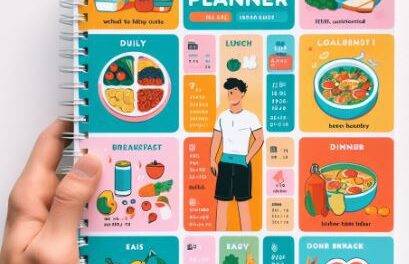Introduction:
How to do a meal plan, Meal planning is the process of deciding what meals and snacks you will eat for a specific period of time, usually a week or a month. It can help you save time and money, eat healthier, and reduce food waste.
Are you tired of the last-minute scramble to figure out what’s for dinner? Does your grocery bill keep climbing because of impulse purchases? It’s time to take control of your meals and your budget by learning how to do a meal plan. Meal planning is not just for nutritionists or professional chefs; it’s a skill that anyone can master. For more information click here.
In this comprehensive guide, we’ll walk you through the process, step by step, making it easy to create a meal plan that suits your lifestyle and goals. for more information on meal planning: Table of Contents: {How to do a meal plan}
Table of Contents: {How to do a meal plan}
- Understanding the Benefits of Meal Planning
- Setting Your Meal Planning Goals
- Inventory Your Kitchen
- Choose Your Meal Planning Style
- Creating a Weekly Meal Plan
- Building a Shopping List
- Preparing Meals in Advance
- Tips for Staying Organized
- Adapting Your Plan to Special Diets
- Embracing Variety and Flexibility
Here is a step-by-step guide on how to do a meal plan:
- Take stock of what you have on hand. Check your pantry, fridge, and freezer to see what food you already have. This will help you avoid buying duplicate ingredients.
- Consider your dietary needs and preferences. Do you have any food allergies or intolerances? Are you following a specific diet? What kind of food do you and your family enjoy eating?
- Think about your schedule. How much time do you have to cook each day? Will you be eating out or cooking at home most of the time?
- Choose recipes. Once you know what you have on hand and what your dietary needs and preferences are, you can start choosing recipes. There are many resources available online and in cookbooks.
- Create a meal plan. Decide what meals and snacks you will eat for each day of the week. Try to choose a variety of meals that are both healthy and delicious.
- Make a grocery list. Once you have a meal plan, you can make a grocery list of all the ingredients you need. Be sure to check your pantry and fridge again before you go shopping to avoid buying things you already have.
Here are some tips for creating a successful meal plan:
- Be realistic. Don’t try to plan too many complicated meals, or you’re more likely to get off track.
- Be flexible. Things happen, so it’s okay to adjust your meal plan as needed.
- Use leftovers. Leftovers can be used for lunch, dinner, or even breakfast the next day.
- Involve your family. If you have a family, get them involved in meal planning and cooking. This will help make mealtimes more enjoyable for everyone.
Here is a sample meal plan for a week:
Breakfast:
- Oatmeal with berries and nuts
- Yogurt with fruit and granola
- Eggs with whole-wheat toast and avocado
- Smoothie made with fruits, vegetables, and yogurt
Lunch:
- Salad with grilled chicken or fish
- Soup and sandwich on whole-wheat bread
- Leftovers from dinner
- Leftovers from breakfast
Dinner:
- Salmon with roasted vegetables
- Chicken stir-fry with brown rice
- Lentil soup
- Spaghetti with meatballs
- Tacos with lean ground beef and whole-wheat tortillas
Snacks:
- Fruits and vegetables
- Nuts and seeds
- Yogurt
- Hard-boiled eggs
This is just a sample meal plan, of course. You can adjust it to fit your own dietary needs and preferences.
Creative meal planning ideas: {How to do a meal plan}
Here are some creative meal planning ideas:
- Theme nights. Have a different theme for each night of the week, such as Mexican night, Italian night, or stir-fry night.
- One-pot meals. One-pot meals are easy to make and clean up after. Try making a chili, soup, or pasta dish in a single pot or Dutch oven.
- Slow cooker meals. Slow cooker meals are another great option for busy weeknights. Simply put all of your ingredients in the slow cooker in the morning and let it cook all day.
- Meal prep. Meal prep involves cooking and preparing meals in advance so that you have healthy food ready to eat when you need it. This can be a great way to save time and eat healthier.
Table: Meal planning benefits {How to do a meal plan}
| Benefit | Description |
|---|---|
| Save time and money | When you have a meal plan, you’re less likely to impulse buy groceries or eat out. |
| Eat healthier | Meal planning helps you make sure that you’re eating a variety of healthy foods throughout the week. |
| Reduce food waste | When you have a meal plan, you’re less likely to buy food that you don’t eat. This can help save you money and reduce food waste. |
Chapter 1: Understanding the Benefits of Meal Planning Meal planning offers a wide range of benefits, including saving time, reducing food waste, and eating healthier. In this chapter, we’ll delve into why meal planning is a game-changer for your daily life.
Chapter 2: Setting Your Meal Planning Goals What are you trying to achieve with your meal plan? Weight loss, budget control, or simply healthier eating? This chapter will guide you in defining clear goals for your meal planning journey.
Chapter 3: Inventory Your Kitchen Before you start planning, take stock of what you already have in your pantry and fridge. This step will help you reduce waste and save money.
Chapter 4: Choose Your Meal Planning Style Discover different meal planning styles, from batch cooking to theme nights, and pick the one that best suits your preferences and schedule.
Chapter 5: Creating a Weekly Meal Plan Learn how to put together a balanced meal plan that considers your dietary needs, family preferences, and busy days.
Chapter 6: Building a Shopping List Maximize efficiency at the grocery store by creating a well-organized shopping list based on your meal plan.
Chapter 7: Preparing Meals in Advance Explore the benefits of meal prep and get practical tips on how to make your weeknights easier.
Chapter 8: Tips for Staying Organized Stay on track with your meal plan using organization techniques and time-saving tricks.
Chapter 9: Adapting Your Plan to Special Diets Whether you’re vegan, gluten-free, or have other dietary restrictions, we’ll show you how to accommodate your needs within your meal plan.
Chapter 10: Embracing Variety and Flexibility Discover how to keep your meal plan exciting and adaptable over time, so you never get bored with your meals.
Conclusion: {How to do a meal plan}
Meal planning is a great way to save time, money, and eat healthier. By following the steps above, you can create a meal plan that works for you and your family.
Congratulations! You’ve now gained the skills to create a meal plan that fits your lifestyle and goals. Meal planning is a powerful tool for taking control of your nutrition, saving time and money, and reducing stress around mealtime. Remember that practice makes perfect, so don’t be discouraged if it takes a little time to find your groove. With dedication and a dash of creativity, you can master the art of meal planning and enjoy the benefits for years to come. By following this step-by-step guide, you’ll not only simplify your daily meal decisions but also improve your overall well-being. Start your meal planning journey today and savor the satisfaction of having delicious, homemade meals waiting for you every day. Bon appétit!.
Summary:{How to do a meal plan}
Meal planning is a powerful tool that can enhance your life in various ways, from saving time and money to promoting healthier eating habits. This summary provides a condensed overview of the key steps to master the art of meal planning:
- Benefits of Meal Planning: Meal planning offers advantages such as time savings, improved nutrition, better budget control, and reduced food waste.
- Getting Started: Begin by assessing your dietary preferences, weekly schedule, and budgetary constraints.
- Gathering Resources: Equip your kitchen with essentials and explore meal planning apps and tools.
- Recipe Selection: Choose recipes that align with your preferences and dietary requirements, and create a recipe repository.
- Batch Cooking: Learn the benefits of batch cooking, techniques, and proper storage methods.
- Creating a Meal Plan: Develop a weekly meal plan that balances nutrition and variety while considering your schedule.
- Building a Shopping List: Translate your meal plan into an organized shopping list.
- Smart Grocery Shopping: Follow tips to stay on budget and make efficient trips to the store.
- Meal Preparation: Prepare ingredients in advance and practice portion control to minimize food waste.
- Adapting and Adjusting: Stay flexible and adapt your plan to handle unexpected changes.
- Special Diets: Tailor your meal planning to accommodate special diets like vegetarian, vegan, gluten-free, or low-carb options.
- FAQs: Find answers to common meal planning questions and challenges.
By following these steps and incorporating meal planning into your routine, you can simplify your life, improve your nutrition, and achieve your personal goals, whether they involve saving time or maintaining a healthier lifestyle.










